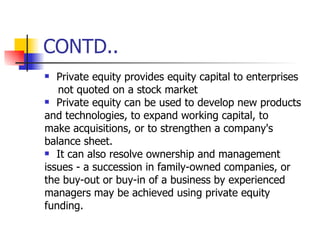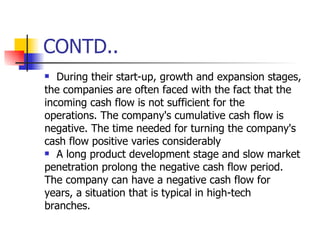Vc
- 1. What is Venture Capital/Private Equity? Venture capital is a subset of private equity and refers to equity investments made for the launch, early development, or expansion of a business Among different countries, there are variations in what is meant by venture capital and private equity In Europe, these terms are generally used interchangeably and venture capital thus includes management buy-outs and buy-ins (MBO/MBIs). This is in contrast to the US, where MBO/MBIs are not classified as venture capital.
- 2. CONTD.. Private equity provides equity capital to enterprises not quoted on a stock market Private equity can be used to develop new products and technologies, to expand working capital, to make acquisitions, or to strengthen a company's balance sheet. It can also resolve ownership and management issues - a succession in family-owned companies, or the buy-out or buy-in of a business by experienced managers may be achieved using private equity funding.
- 3. Why companies need financing? For start-ups or growing companies, as well as those facing a major change, financing is one of the key business issues. New capital is needed e.g. for 1. Financing of product development 2. Financing of market penetration 3. Financing of investments 4. Working capital financing to secure operative continuity 5. Maintaining liquidity to be able to cover daily payments
- 4. CONTD.. During their start-up, growth and expansion stages, the companies are often faced with the fact that the incoming cash flow is not sufficient for the operations. The company's cumulative cash flow is negative. The time needed for turning the company's cash flow positive varies considerably A long product development stage and slow market penetration prolong the negative cash flow period. The company can have a negative cash flow for years, a situation that is typical in high-tech branches.
- 5. Operative financing To bridge the deficit in operative financing, the company has the following choice of available measures: 1. to ensure that the liquidity planning has been appropriate 2. to make the clients pay their invoices on time by offering, for example, discounts for rapid payments 3. to intensify the collection of sales receivables 4. to delay the payments to suppliers within their terms of payment 5. to maximize the sales margins to cut indirect costs
- 6. External financing Should these measures not be sufficient, the company has the following alternatives: to acquire equity capital (e.g. venture capital investors) to borrow capital to apply for public subsidies
- 7. The Process of acquiring Venture Capital financing The actual venture capital investment made in a company is preceded by a thorough and selective assessment of potential investment targets made by the venture capital investor. At the first stage, the assessment of the investment request is based on a business plan made by the company. This is the stage where most of the projects (about 90 %) of all proposed projects are rejected. The initial assessment is made relatively rapidly and therefore the company should pay attention to two aspects: the business plan should be carefully prepared and the contact targeted to the correct investors. A well-prepared business plan summary is the best means of attracting and convincing the investor.
- 8. CONTD.. The central issues considered by the venture capital investor at this stage are: Is the company able to conduct profitable and growing business operations? Do the company executives have the necessary qualities to manage the business in the various development stages? Will the investor be able to obtain the desired return through an increase in the company's net worth?
- 9. CONTD.. Besides the company's business plan, the venture capital investor will assess the compatibility of the investment request against its own investment strategy The decisive investment strategy criteria may be company size, development stage, branch or geographical location. Contacts directed to the correct investors at an early stage of the process will save time and diminish the probability of negative answers.
- 10. CONTD.. Should the investor decide that the investment request meets his criteria, the following step is a meeting arranged with the company management Experience has shown that about half of the remaining companies are discarded at the negotiation stage
- 11. The third stage, or the due diligence stage, involves a thorough study of the target company by the venture capital investor who assesses the company on the basis of his own, weighted investment criteria. The preparedness of the company management to launch and developed the business in question is generally seen as the most important criterion. Other vital issues include the size and development of the company's target market, the competitiveness of the company's product and technology as well as the capital required by the business at the actual investment stage and the eventual additional investment needs.
- 12. CONTD.. During the second and third stage of the assessment process, the investor determines the value of the company. Once the entrepreneur and the investor have agreed on the value, the investor's future share of the company is determined. The entry valuation of investor will depend on factors such as investors return expectations, propotion of the company that the management will give up to attract the investments and the view of the opportunity for new concept, product or service
- 13. CONTD.. The intention is to liquidate the shareholding in early phase companies after 4-8 years and in companies with follow-on funding after 1-3 years In the end, the investment is made in about 3 to 4 % cases of all received investment requests. The parties finally make a shareholder agreement to establish practical operating rules. VC’s exit could be anything between liquidation and IPO
- 14. Stages of Investments Early stage companies may have proprietary technology or intellectual property that has the potential to be exploited on a global scale. The technology or lead product is usually beyond proof of principle stage Mid-stage companies may have strong pipeline of technologies and products, which has been developed by research and management teams with scientific and commercial credibility Later stage companies have operational and corporate finance skills ideally positioned and company may need investments to precipitate consodilations. Companies at this stage are within 12 to 18 months of an IPO.
- 15. VC’s contribution to entrepreneur In addition to money, professional VC as a shareholder bring strong industry, operational, financial and investment banking skills to the partnership with the target company Through the VC’s expertise and network the portfolio companies could gain access to: a) follow-on capital through venture capital ties b) knowledge of partnership opportunities in multiple markets c) in-depth operational and management experience’ d) access to high-quality management teams e) ties to the investment banking community
- 16. CONTD.. VC adds the most value by assisting in the creation of the best possible team to manage and supervise the target company Management assessment is one of the major tasks to be carried out by the venture capital before deciding to invest
- 17. Ten Questions Your Business Plan Should Answer From The VC’s Point Of View 1. Where is the company now? 2. What is your product or service? 3. What is your market? 4. How will you reach the market? 5. Who will you be competing against? 6. How will your product be produced? 7. Who are the people? 8. What are your financial projections? 9. How much money will you need? 10. What are the risks?

















